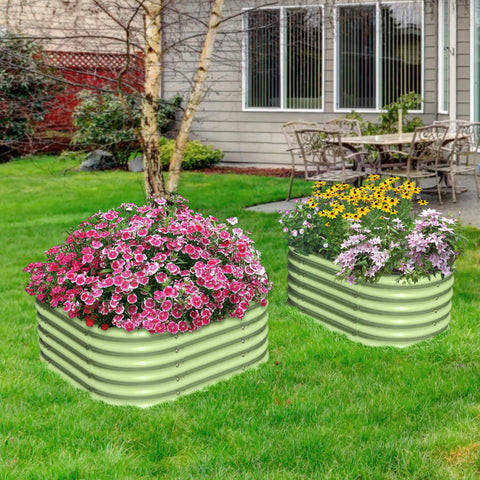How to Choose a Suitable Height for a Metal Garden Bed?
With the acceleration of urbanization, more and more people are starting to cultivate vegetables or flowers as their hobbies, and metal garden beds have become a popular planting tool. However, the height of the metal garden bed has a significant impact on the success of planting and the experience of using the bed. So, how high should we choose a metal garden bed? Let's explore this issue now.
Firstly, the height of the metal garden bed should take into account the needs of planting. If you are growing vegetables, the height of the bed should be between 12 to 20 inches. This height allows sufficient space for the root system of vegetables to develop, and also makes it easier for you to manage the vegetables on the bed. If you are planting flowers, the height of the bed can be slightly higher, preferably between 20 to 32 inches. This can make the roots of flowers healthier and also allow you to better appreciate the beauty of flowers.
Secondly, the height of the metal garden bed should also take into account the physical condition of the grower and the convenience of use. If you are relatively healthy, a bed with a height of around 20 inches will be more suitable for you. This height can not only meet the growth needs of vegetables and flowers, but also make it easier for you to manage the plants on the bed. If your physical condition is not good, or if your metal garden bed is relatively large, a bed with a height of around 32 inches may be more suitable for you. This height allows you to easily manage the plants on the bed without bending down, reducing the burden on your body.
Finally, the height of the metal garden bed should also take into account your planting purpose and budget. If your planting purpose is mainly for your own daily needs, a bed with a height between 12 and 20 inches is sufficient. If you want to create a beautiful garden with sufficient budget, a bed with a height between 20 and 32 inches will be more suitable for you. Of course, if you have sufficient budget, you can also choose to customize metal garden beds with higher heights to meet your planting and aesthetic needs.
Overall, choosing the height of a metal garden bed should take into account multiple factors such as the needs of the plant, the physical condition and ease of use of the grower, as well as the planting purpose and budget. When choosing a height, it is necessary to weigh the relationships between various factors in order to find the most suitable height. At the same time, it should be noted that the height of the metal garden bed is not the only factor that affects the success of planting and user experience, but also needs to consider multiple factors such as bed size, material, drainage performance, and sunlight.
In addition to height, the design and material of the metal garden bed also need to be noted. Generally speaking, metal garden beds can be made of durable and corrosion-resistant materials such as galvanized steel plate, stainless steel, aluminum alloy, etc. The design of the bed also needs to consider factors such as drainage performance and ease of movement to improve the success rate of planting and the convenience of use.
When choosing a metal garden bed, it is also necessary to consider the size of the bed. The size of the bed should be determined based on the needs of the grower and the size of the planting area. If you just want to grow some vegetables or flowers for your own consumption, a smaller bed can meet your needs. If you want to create a large garden or grow a large amount of vegetables, you need to choose a larger bed.
In summary, the height of a metal garden bed should be determined based on factors such as plant needs, the physical condition and ease of use of the grower, planting objectives, and budget. When choosing the height of the bed, it is necessary to comprehensively consider the relationship between various factors in order to find the most suitable height. In addition to height, the design, material, size, and other factors of the bed also need to be noted to improve the success rate of planting and the convenience of use.


